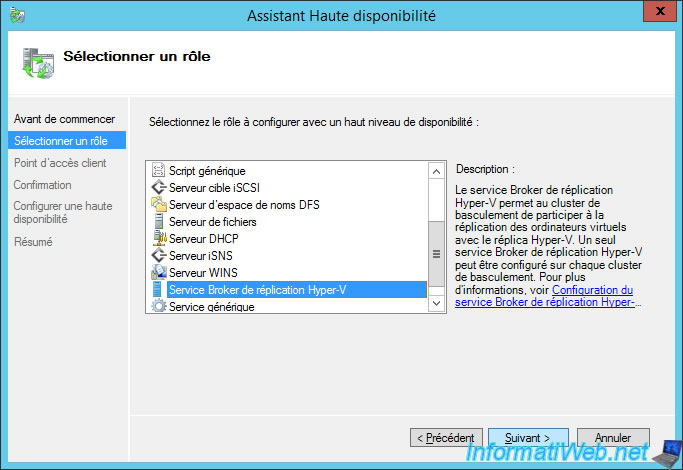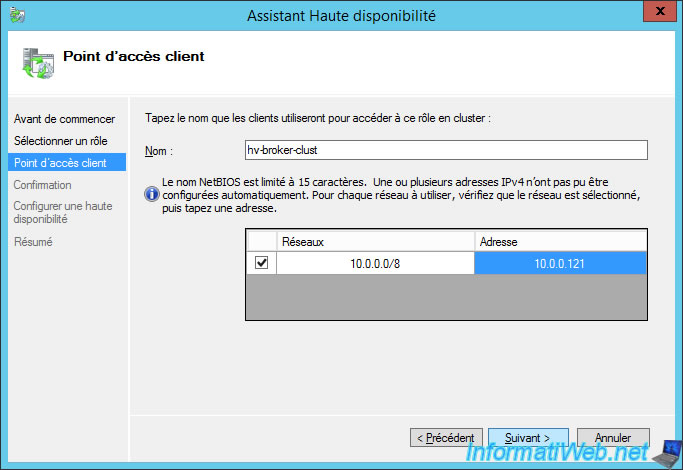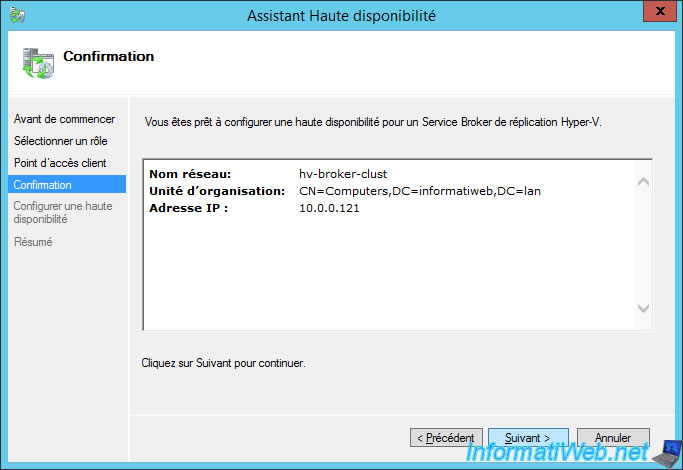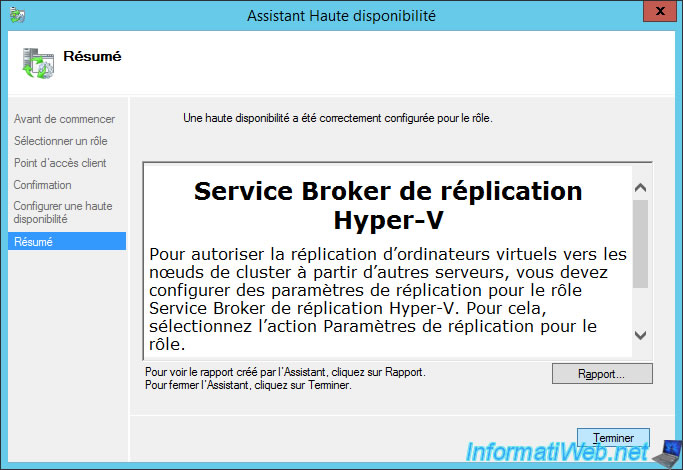- Microsoft
- 06 December 2019 at 19:09 UTC
-

- 1/4
When you created your Hyper-V cluster, you probably noticed that there were 2 Hyper-V roles that you could cluster :
- Virtual Machine : allows you to add an existing virtual machine to a cluster
- Hyper-V Replica Broker : allows you to replicate virtual machines from one cluster to another
In this tutorial, we will explain how to implement this automatic replication of VMs from one Hyper-V cluster to another cluster through the "Hyper-V Replica Broker" role.
The advantage of this role is that the configuration of Hyper-V replication should only be done once per cluster and not on each node of your cluster.
Note that the principle is the same as when you configure automatic replication between 2 Hyper-V servers that are not clustered.
To learn more about the different replication options offered by Hyper-V on Windows Server 2012, 2012 R2 and 2016, refer to our tutorials :
- Automatically replicate virtual machines from one server to another (HTTP)
- Automatically replicate virtual machines securely (HTTPS)
- Configuration used
- Install the clustered role : Hyper-V Replica Broker
- Configure broker's replication settings
- Configure replication settings on the remote cluster
- Testing replication from one Hyper-V cluster to another through the replication broker
- Generate certificates for Hyper-V clusters
- Generate certificates for Hyper-V servers
- Deploy cluster certificates
1. Configuration used
For this tutorial, we will use 2 Hyper-V clusters with 2 servers in each cluster.
2. Install the clustered role : Hyper-V Replica Broker
To start, on your 1st Hyper-V cluster, right-click on Roles and click on : Configure Role.

The High Availability wizard is displayed.
Select the "Hyper-V Replica Broker" role that enables the cluster to replicate virtual machines with the Hyper-V Replica.

Provide a name and IP address for this Hyper-V Replica Broker.
Note : this is the name or IP address that you will need to allow on the remote cluster in the replication settings of this broker service.

A summary is displayed.

As noted by the wizard, for this service to work, you will need to configure the replication settings from this role : Hyper-V Replica Broker.

The Hyper-V Replica Broker is now running.

Like any clustered role, a computer account has been created automatically on your Active Directory server.

Don't forget to add this role to the remote cluster as well.
In our case, it's our backup cluster (hence the "dr" for Disaster Recovery).

3. Configure broker's replication settings
On your 1st Hyper-V cluster, right-click the Hyper-V Replica Broker and click : Replication Settings.

In the "Hyper-V Replica Broker Configuration" window that appears :
- enable this cluster as a replication server
- choose the authentication method : Use Kerberos (HTTP)
- at the bottom, select "Allow replication from the specified servers"
Note that using HTTPS requires certificates. We will see that later in this tutorial.

Specify the name of the Broker installed on the remote cluster as the primary server, and then click Browse.

Because your Hyper-V servers are clustered, you will need to store copies of your virtual machines in a cluster shared volume so that all nodes of your cluster can access them.

For the trusted group, you can put what you want.
In our case, we have indicated that this is an authorization for our backup Hyper-V servers.

Click OK.

For replication to be possible, you will need to allow the used listener (HTTP in this case) into the firewall of your Hyper-V servers.

Enable the rule : Hyper-V Replica HTTP Listener (TCP-In)

4. Configure replication settings on the remote cluster
On your remote cluster (the standby environment), make sure you have configured at least 1 cluster shared volume to store copies of your virtual machines.

Then, don't forget to also configure the replication settings from the "Hyper-V Replica Broker" role.

In the replication settings :
- enable this cluster as a replication server
- check the "Use Kerberos (HTTP)" box
- and allow the name of the Hyper-V Replica Broker of your 1st Hyper-V cluster
- store copies of the virtual machines on the cluster shared volume so that all the nodes of your cluster can access them

Remember to also enable this rule on your backup Hyper-V servers : Hyper-V Replica HTTP Listener (TCP-In)

Share this tutorial
To see also
-

Microsoft 9/6/2019
Hyper-V (WS 2012 R2 / 2016) - Create a generation 2 VM
-

Microsoft 8/10/2019
Hyper-V (WS 2012 R2 / 2016) - Install Hyper-V and create your first VM
-

Microsoft 11/8/2019
Hyper-V (WS 2012 R2 / WS 2016) - Automatically replicate virtual machines
-

Microsoft 11/15/2019
Hyper-V (WS 2012 R2 / WS 2016) - Automatically replicate virtual machines (securely)


You must be logged in to post a comment